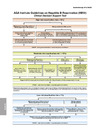Background
Hepatitis B virus (HBV) reactivation is a well-described clinical entity characterized by a rise in HBV DNA and typically followed by a rise in aminotransferase levels.[1] Although HBV reactivation can occur spontaneously or in the setting of hepatitis C virus (HCV) treatment, it is most commonly triggered by immunosuppression.[2] In addition, in persons receiving treatment for HBV, reactivation almost always occurs following withdrawal of HBV antiviral therapy. Reactivation of HBV can lead to acute hepatitis and even liver failure; these complications, however, can be prevented with the use of antiviral therapy, when indicated.
Definitions
The following summarizes the American Association for the Study of Liver Diseases (AASLD) definitions related to HBV reactivation.[3]
- Hepatitis B Reactivation: Hepatitis B virus reactivation is the loss of HBV immune control in persons who are receiving immunosuppressive therapy for a concomitant medical condition and at baseline are either (1) hepatitis B surface antigen (HBsAg)-positive and anti-HBc-positive or (2) HBsAg-negative and anti-HBc-positive.
- Among persons who are HBsAg-positive and anti-HBc-positive, the AASLD defines loss of immune control constituting reactivation as:
- HBV DNA level that increases 100-fold (2-log) or greater compared to the baseline level;
- HBV DNA level of 1,000 IU/mL or greater in a person with a previously undetectable level (given that HBV-DNA levels fluctuate); or
- HBV DNA level of 10,000 IU/mL or greater if the baseline level is not available.
- Among persons who are HBsAg-negative and anti-HBc-positive, the AASLD defines loss of immune control constituting reactivation as:
- Detectable HBV DNA, or
- Reversal of HBsAg seroconversion occurs (reappearance of HBsAg).
- Among persons who are HBsAg-positive and anti-HBc-positive, the AASLD defines loss of immune control constituting reactivation as:
- Hepatitis B Flare: Typically, HBV flares accompany HBV reactivation and are defined as an alanine aminotransferase level (ALT) increase of at least 3 times baseline and reaching an absolute value greater than 100 U/L.
- HBV-Associated Liver Failure: HBV reactivation can result in liver failure, which the AASLD defines as at least one of the following:
- Impaired synthetic function (total bilirubin greater than 3 mg /dL or an international normalized ratio [INR] greater than 1.5);
- Ascites;
- Encephalopathy;
- Death following HBV-associated liver failure is attributed to HBV reactivation.









